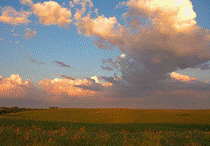
Proceedings of the North American Prairie Conferences
Date of this Version
1989
Document Type
Article
Abstract
Stands of eastern redcedar (Juniperus virginiana L.) have been increasing in prairies, often to the detriment of valuable prairie species. Initial control of dense stands of relatively tall eastern redcedar by herbicides may be necessary to alter population demographics before more environmentally sound mechanical methods and prescribed burning can be employed to maintain acceptable populations of this woody species. Previous control effectiveness with herbicides has been highly variable. This study was conducted to determine the effect of hexazinone [3-cyclohexyl- 6-(dimethylamino)-1-methyl-l ,3 ,5-triazine-2,4( IH,3H)-dione] as Velpar L, picloram (4-amino-3 ,5 ,6-trichlora-2-pyridinecarboxylic acid) as Tordon 2K, and tebuthiuron N-[5-(1, I-dimethylethyl)-1 ,3,4-thiadiazol-2-yl]N,N'-dimethylurea as Graslan brush bullets on eastern redcedar in the mixed prairie of central Nebraska. Each herbicide was soil applied at three rates, adjusted for tree height, spanning the manufacturers' range of recommended rates. Picloram and tebuthiuron were applied in October, and hexazinone was applied in May. Success of control was recorded after two growing seasons. Depending on application rate and tree height, hexazinone killed between 68 and 90%, picloram 70 to 94%, and tebuthiuron 71 to 90% of the trees. Although all herbicides preformed well in controlling eastern redcedar, picloram generally provided greater control than the two other chemicals. Picloram also achieved this control with a relatively low material cost.


Comments
Published in Prairie Pioneers: Ecology, History and Culture: Proceedings of the Eleventh North American Prairie Conference, August 7-11, 1988, Lincoln, Nebraska (Lincoln, NE 1989).